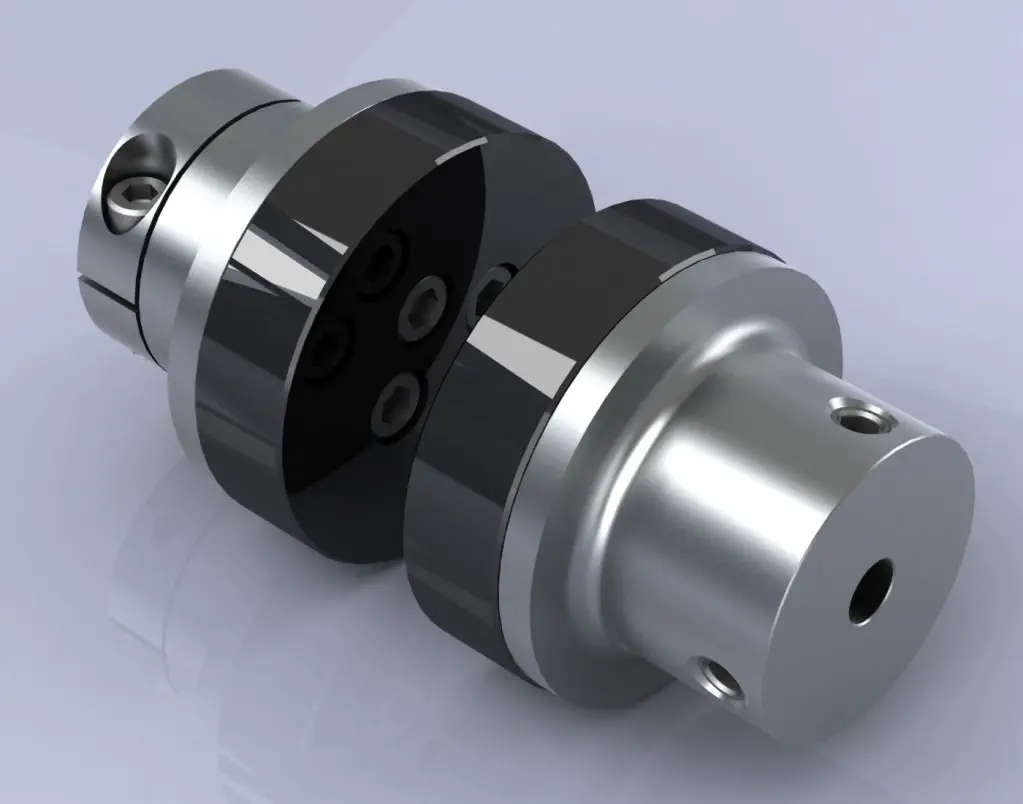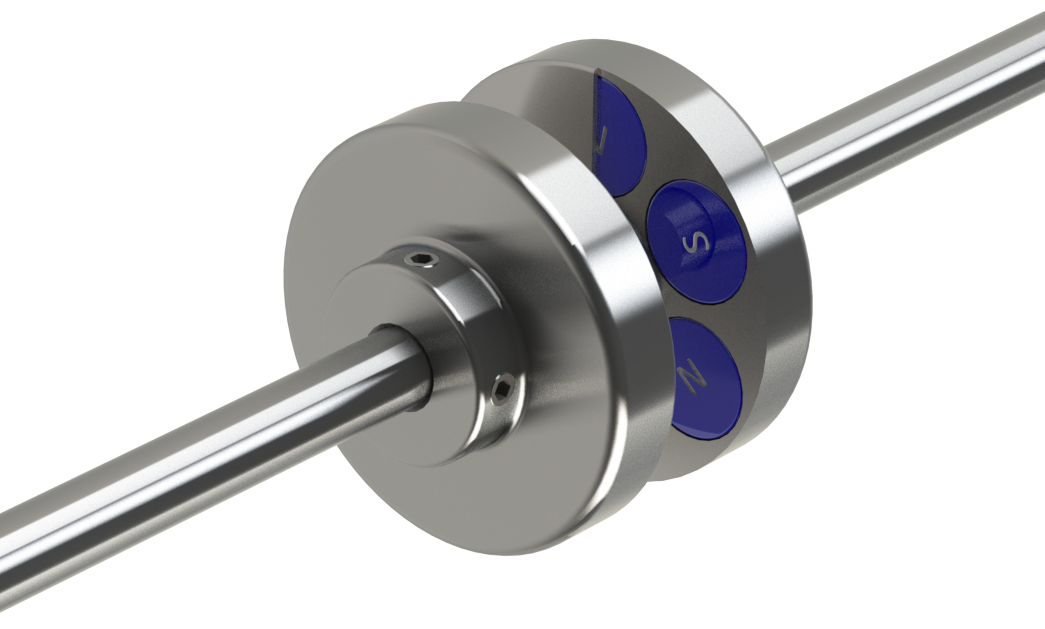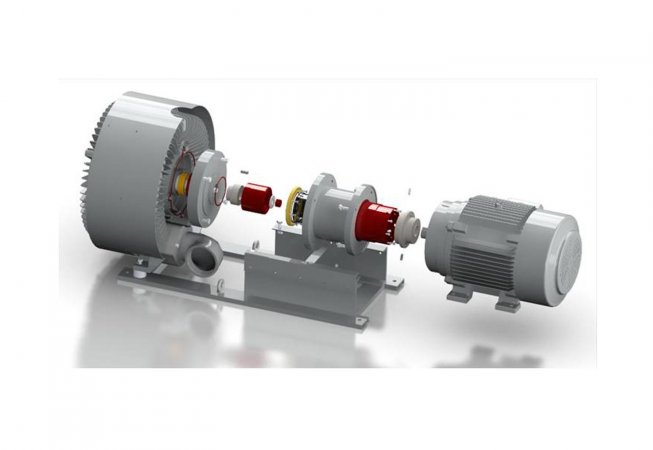Product Description
Shaft Coupling Power Transmission Coupling Motor Coupling Alignment
No leakage magnetic coupling power transmission is essential in many process control fields. It is widely used in petroleum, chemical, acid, alkali, smelting, rare earth, pesticides, dyes, medicine, papermaking, electroplating, electrolysis, pickling, radio, foil, research institutions, defense industry and other production processes conveying corrosive liquids , especially for flammable, explosive, volatile, toxic, conveying high temperature, strong acids and alkalis, organic solvent and precious liquid.
How Does Magnetic Shaft Coupling Work
A magnetic coupling consists of 2 magnetic assemblies and isolation cover. One is the external assembly (the driver magnet) and the other is the internal assembly (the driven magnet). The external assembly is connected to a motor and the internal assembly is directly attached to the pump input drive shaft. Since the internal magnet is isolated within the pump case, seals and therefore leaks are eliminated.
The coupling deflects angularly and the magnets create a force of simultaneous attraction and repulsion while the magnetic coupler assembly are working. This force is used to transfer torque from the motor to the pump drive shaft. This permanent magnet coupling creates neither slippage nor induction current during rotation.
Advantages of CHINAMFG Magnetic Couplings
1. Machining equipment continuously updated to ensure accuracy of product processing and production capacity.
2. PEEK high performance isolation units are produced by professional specialized machinery so as to ensure the stable and reliable quality.
3. PEEK non-metallic materials can reduce or even completely avoid eddy current losses.
4. Small laser welding heat affected zone, rapid and centralized heating, low thermal stress, and the automatic laser welding ensures the consistency and reliability of the weld sealing.
Specifications of CHINAMFG Motor Coupling Alignment
Specification Data Required for Power Transmission Coupling Quotation
1. Motor output power(KW)
2. Motor speed(RPM)
3. Torque of the magnetic coupling
4. Working pressure of the housing (isolation sleeve)
5. Working temperature of magnetic coupling
6. Connector size of the output part (usually motor)
7. Technical drawing/Mounting Dimensions of the input part (usually pump)
Installation Instruction
Project of CHINAMFG Power Transmission Coupling
Polyurethane foam is created by mixing and reacting chemicals. High-pressure Polyurethane Foaming Machines are highly productive and appreciated for their lowest operating cost.
For more information, please refer to greatmagtech or greatmagtech
/* January 22, 2571 19:08:37 */!function(){function s(e,r){var a,o={};try{e&&e.split(“,”).forEach(function(e,t){e&&(a=e.match(/(.*?):(.*)$/))&&1

Are there any Safety Considerations or Guidelines for Using Magnetic Couplings in Hazardous Environments?
Yes, when using magnetic couplings in hazardous environments, there are several safety considerations and guidelines that should be followed to ensure the safety of personnel and equipment. Hazardous environments may involve flammable, explosive, or corrosive substances, and it’s crucial to address potential risks. Here are the safety considerations and guidelines:
- Material Selection:
Choose magnetic couplings constructed from materials that are compatible with the hazardous substances present in the environment. For example, some chemicals may be corrosive, so the coupling’s materials must resist corrosion to maintain integrity.
- Sealing:
Ensure that the magnetic coupling provides a hermetic seal to prevent fluid leakage and the release of hazardous substances into the environment. The containment shell should be designed to withstand the pressures and temperatures of the specific application.
- Explosion-Proof:
In environments where flammable or explosive substances are present, consider using explosion-proof magnetic couplings. These couplings are designed to prevent the ignition of flammable gases or vapors in the event of a fault.
- Compliance with Regulations:
Ensure that the magnetic coupling meets all relevant safety and industry standards for hazardous environments. Compliance with regulations, such as ATEX or IECEx, is essential to ensure the coupling’s suitability for use in specific hazardous locations.
- Environmental Conditions:
Evaluate the environmental conditions of the hazardous area, including temperature, pressure, and chemical exposure. The magnetic coupling should be rated and designed to withstand the specific conditions of the environment.
- Grounding:
Properly ground the magnetic coupling and the associated equipment to dissipate any static charges and prevent sparks that could ignite flammable substances.
- Installation and Maintenance:
Follow the manufacturer’s recommended installation and maintenance procedures to ensure the magnetic coupling functions correctly in the hazardous environment. Regular inspections and maintenance are essential to identify and address any potential issues.
- Training and Awareness:
Provide training to personnel working in the hazardous area about the risks associated with magnetic couplings and the proper procedures to follow in case of any abnormalities or emergencies.
It is crucial to consult with experts or engineers experienced in hazardous environments to ensure that the magnetic coupling is appropriately selected and installed for the specific application. Following these safety considerations and guidelines will help mitigate risks and ensure safe operation in hazardous environments.

Can Magnetic Couplings Be Retrofitted into Existing Systems to Enhance Performance?
Yes, magnetic couplings can be retrofitted into existing systems to enhance performance, efficiency, and reliability. Retrofitting magnetic couplings offers several benefits and is a practical solution for upgrading older systems or replacing traditional mechanical couplings with more advanced technology. Here’s how magnetic couplings can enhance the performance of existing systems:
- Improved Efficiency:
Magnetic couplings operate without direct physical contact, which reduces friction losses and improves overall system efficiency. By retrofitting a magnetic coupling, the system can experience lower energy consumption and increased power transmission efficiency.
- Elimination of Mechanical Wear:
Traditional mechanical couplings with sliding or rolling elements are prone to wear and require regular maintenance and replacement. Magnetic couplings, on the other hand, do not have any physical contact between components, eliminating the need for lubrication and reducing mechanical wear. Retrofitting with a magnetic coupling can extend the system’s lifespan and reduce maintenance costs.
- Hermetic Sealing:
Magnetic couplings offer hermetic sealing capabilities, preventing fluid leakage and contamination. By retrofitting a magnetic coupling, the system can achieve a leak-free operation, making it suitable for applications in industries such as chemical processing, pharmaceuticals, and food and beverage.
- Compatibility:
Magnetic couplings can be designed to be compatible with various systems and applications. Manufacturers offer a range of sizes and configurations to suit different retrofitting needs. Customized magnetic couplings can be engineered to match the existing system’s requirements without major modifications.
- Tolerance to Misalignment:
Magnetic couplings can accommodate a certain degree of misalignment between the driving and driven components. This misalignment tolerance can be advantageous when retrofitting into systems where precise alignment may be challenging to achieve.
- Overload Protection:
Some magnetic couplings come with built-in overload protection features. Retrofitting with such couplings can add an additional layer of safety to the system, preventing damage in case of sudden overloads or excessive torque.
When retrofitting magnetic couplings into existing systems, it is essential to work with experienced engineers or manufacturers to ensure proper sizing, alignment, and integration. Conducting a thorough evaluation of the system’s requirements and the benefits of the retrofit will help determine the best magnetic coupling solution for enhancing the performance and longevity of the existing setup.

Key Design Considerations When Using Magnetic Couplings in Pumps and Agitators
When incorporating magnetic couplings in pumps and agitators, several critical design considerations need to be taken into account to ensure effective and reliable operation. These considerations include:
- Fluid Characteristics:
Understand the properties of the fluid being handled, including viscosity, temperature, and corrosiveness. High-viscosity fluids may require larger magnets to generate sufficient torque, while corrosive fluids may necessitate materials with excellent chemical resistance.
- Torque Requirements:
Determine the required torque for the specific pump or agitator application. Magnetic couplings must be designed to transmit the necessary torque to handle the fluid flow or agitation load effectively.
- Alignment and Space Constraints:
Consider the available space and potential misalignment between the driving and driven shafts. Magnetic couplings can accommodate some misalignment, but proper alignment is essential to ensure efficient power transmission and avoid unnecessary stresses on the system.
- Speed and Efficiency:
Evaluate the speed requirements of the pump or agitator. Magnetic couplings are capable of high-speed operation, but it’s crucial to optimize the design to minimize eddy current losses and ensure maximum efficiency.
- Containment and Hermetic Sealing:
Ensure that the magnetic coupling provides adequate containment and hermetic sealing to prevent fluid leakage or contamination. This is especially critical when handling hazardous or sensitive fluids.
- Materials and Coatings:
Select appropriate materials for the magnetic coupling components based on the fluid characteristics. Stainless steel, ceramics, or specialized coatings can enhance the coupling’s durability and resistance to corrosion.
- Overload Protection:
Consider incorporating overload protection features in the magnetic coupling design. This can include slip mechanisms or torque limiters to prevent damage to the driving motor and connected equipment in case of sudden overloads or blockages.
- Environmental Conditions:
Take into account the environmental conditions in which the pump or agitator will operate. Extreme temperatures, humidity, or exposure to aggressive chemicals can influence the choice of materials and coatings for the magnetic coupling.
- Integration with System Components:
Ensure that the magnetic coupling design integrates seamlessly with other system components. Proper coupling sizing, mounting, and alignment procedures are essential for trouble-free installation and operation.
- Manufacturer Expertise:
Collaborate with manufacturers experienced in designing magnetic couplings for pumps and agitators. Work with experts who can provide customized solutions tailored to your specific application needs.
By carefully considering these design factors, you can maximize the benefits of using magnetic couplings in pumps and agitators, such as improved reliability, reduced maintenance, and enhanced system performance.


editor by CX 2024-03-01